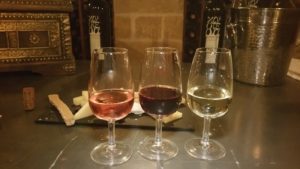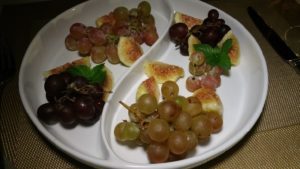14 Sep A Great Grape Experience in Greece
This story originally appeared in the Napa Valley Register.
In the Northern Hemisphere, harvest is well underway. In many places, the grapes have already been picked and pressed, and the juice is fermenting. As the wine is being made, what happens to the skins?
In most cases, it is used as compost and in some cases it is turned into grappa. But there are so many other uses for grapes and skins as I recently experienced during my stay at the Kinsterna Hotel and Spa in Greece.
Kinsterna Hotel and Spa is located in Monemvasia in the region of Laconia in the south of the Peloponnese. The hotel, a fortified manor that dates to the 12th century, sits on a hillside covered with olive trees and vineyards.
Kinsterna has their own wine label and produces three wines using historic indigenous varieties. The white wine is made with the grapes monemvasia (also called malvasia), kydonitsa and assyrtiko, and the wine is young and fresh with citrus and pineapple notes and soft acidity on the palate.
The red wine is made with 90 percent agiorgitiko and 10 percent mavroudi resulting in an easy-drinking wine with notes of red fruits and low tannins. They also have a rosé wine made with malagouzia, moscofilero and agiorgitiko that is off-dry with dominant notes of rose petals and cherry.
But during harvest season, Kinsterna has found many other ways to use the grapes, skins and seeds throughout the property.
At one of the restaurants on the property, the grapes have been incorporated into dishes. A simple plate of fresh figs and wine grapes was offered for dessert. But my favorite dish was salad prepared with lettuce, grilled Haloumi cheese, wine grapes, almonds and Oxymelo dressing, a dressing made with barrel aged vinegar and thyme honey. The sweetness of the grapes with the saltiness of the cheese made for a flavorful salad that was ideal to eat for lunch in the hot sun.

Behind the bar
With a robust garden on the property, bar manager Nicolas Karitsiotis has many fresh ingredients to work with behind the bar. And, he makes everything he possibly can from scratch. So during harvest, he takes advantage of the grapes. He can be found making special wine-based cocktails but he is also involved in making other products.

Using the grape skins, Karitsiotis is making the popular Greek distilled spirit tsipouro. To make tsipouro, the skins of the grapes are taken immediately after the first press when the skins are still fresh. After a long fermentation of 40 days, it is followed by distillation, resulting in a strong wine brandy that is a bit smoother than grappa.
Using grape must that is not made into wine, Karitsiotis also made petimezi, a grape molasses. The grape must is boiled and reduced to a thin honey-like syrup that is sweet with bitter undertones. Petimezi has notes of brown sugar and caramel and good acidity. It is delicious on top of ice cream.
Offering a variety of scrubs and massages, the highlight in the spa during harvest season is titled “Grape Expectations.” This treatment begins with an invigorating body scrub with grape seeds and is followed by a body mask made from red grape skins. Thanks to the polyphenols that are found in the grape seeds and skins, which have an anti-oxidant power 20 times stronger than vitamin C, skin is left glowing.
A 12th-century facility, there is a lot of old equipment on the property, including an old wine press and open air concrete tank. Grapes are brought over from the vineyard and guests can foot stomp the grapes as well as enjoy moustalevria, a traditional Greek pudding made by taking grape must and cooking it with honey, sesame, cinnamon, almonds and semolina to thicken it. It is quite delicious.
Kinsterna Hotel and Spa is a sustainable property, focused on local and natural products and producing what they can onsite. Local natural toiletries, pools filled with running spring water, endemic plants and herbs in the garden, procurement of local organic and free-range meats, organic waste treatment of sewage and the use of local and natural building materials are just some of the many ways they embody Green practices.
Using all parts of the grapes in a variety of creative uses fits in line with these practices and for guests, it is a lot of fun.
Read the original story in the Napa Valley Register.
Discover more from Please The Palate
Subscribe to get the latest posts sent to your email.










